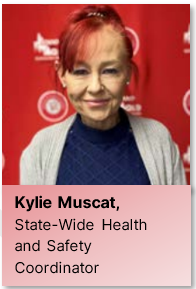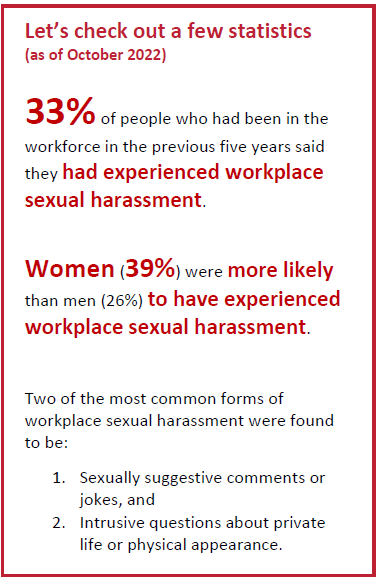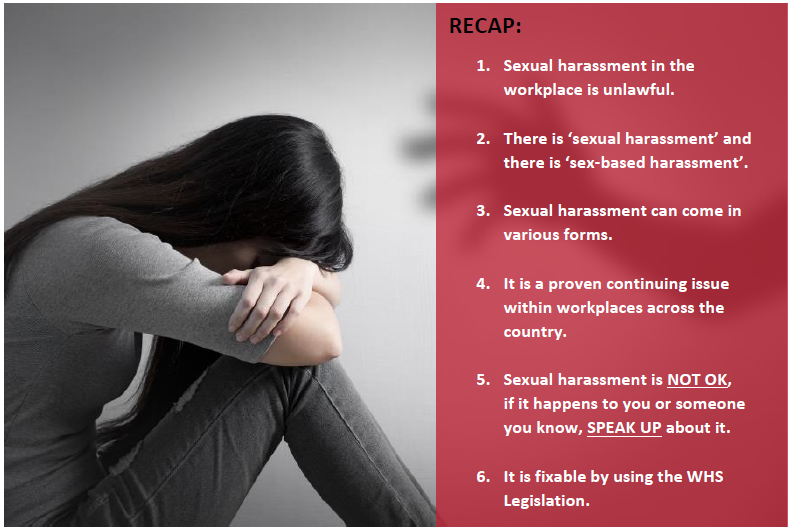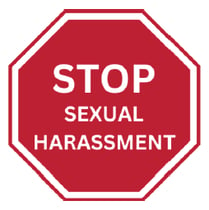HSR News January 2023 | Dealing with sexual harassment at work
 Welcome back to a brand-new exciting year!
Welcome back to a brand-new exciting year!
2023 is going to be the year for increased numbers of HSRs within workplaces. It is going to be the year the Psychosocial Hazard Code of Practice and Regulation will apply, the outcome of the WHS Act Review and lots more. 2023 is going to be all about prevention. Having good WHS structures in place that ensure the best safe working environment for all workers, preventing injuries before they occur, instead of waiting until a worker is hurt.
Keeping this in mind, for our first addition in 2023 I would like to still focus on the Psychosocial Code of Practice, but I want to dig a little more into that and this month talk about ‘Sexual Harassment’.
What is sexual harassment?
 Sexual harassment is against the law in Queensland. It is prohibited by the Anti-Discrimination Act 1991.
Sexual harassment is against the law in Queensland. It is prohibited by the Anti-Discrimination Act 1991.
Sexual harassment is any unwelcome conduct of a sexual nature that is done either to offend, humiliate or intimidate another person, or where it is reasonable to expect the person might feel that way.
This includes any uninvited physical intimacy such as touching in a sexual way, uninvited sexual propositions, and remarks with sexual connotations.
Sexual harassment can take various forms and may be obvious or subtle, physical or verbal.
Sexual harassment does not have to be repeated or continuous to be against the law. A single act can be unlawful.
If that explains ‘sexual harassment’, then what is ‘Sex Based Harassment’?
Sex based harassment is the harassment of a person on the basis of their sex or gender/gender identity that is of a demeaning nature that a reasonable person would find offensive, humiliating or intimidating.
 In addition to this, other factors that may increase the likelihood that a person may experience sexual harassment:
In addition to this, other factors that may increase the likelihood that a person may experience sexual harassment:
- Young workers
- LGBTQI workers
- Aboriginal and Torres Strait Islander workers
- Workers with a disability
- Culturally and linguistically diverse backgrounds
- Migrant workers
- Work that is precarious or insecure.
How much of the behaviour is about “sexual conduct” vs conduct of a sexual nature designed to offend, humiliate, or intimidate?
Now that we have a clear understanding of what sexual harassment in the workplace is and the differences between that and sex-based harassment, then how much of an issue at work is it really?
CASE STUDY: Sexual Harassment at Work
A woman in a laundromat was subjected to escalating unwelcome conduct from her boss, and work was withheld from her when she rejected his advances. She had the sole financial responsibility for her children. English is her second language, and she was significantly younger than her boss. The tribunal said the combination of these factors checked every measure encapsulated under section 120 of the Act (Meaning of relevant circumstances for determining whether a reasonable person would have anticipated the possibility that the other person would be offended, humiliated, or intimidated by the conduct).
The sexual harassment included inappropriate touching of the woman’s bottom and legs, forcing the woman to touch the man’s genitals, asking for massages, repeated requests for sex, and explicit text messages. The tribunal referred to the conduct as transactional, as the woman was required to accede, or she would not be offered work.
The man claimed that the woman would stick her bottom out when he had to get past her when she was folding laundry, and it was a game between them. He also claimed that the text messages and sexual references were just banter. The tribunal preferred the evidence of the woman.
Eventually the woman reported the behaviour to the police, and the police advised her not to return to the workplace due to fears for her safety. She also lodged a successful claim for workers’ compensation.
The tribunal found that the conduct constituted both sexual harassment and sex discrimination.
In this case there was medical evidence that the woman experienced anxiety, and she felt unsettled and easily agitated. She became short-tempered and her sleep became erratic, and she commenced a course of antidepressant medication. The woman was diagnosed with Adjustment Disorder and Mixed Anxiety and Depressed Moods, arising as a consequence of the workplace sexual harassment.
Golding v Sippel and The Laundry Chute Pty Ltd [2021] QIRC 074

 Addressing sexual harassment in the workplace
Addressing sexual harassment in the workplace
Sexual harassment is a psychosocial hazard, as this hazard refers to the physical, mental, and social state of a person. Sexual harassment has the potential to inflict any or all of these injuries. Therefore, when addressing this issue and/or doing a risk assessment in the workplace it is a must to apply the control measures as outlined within the code of practice.



